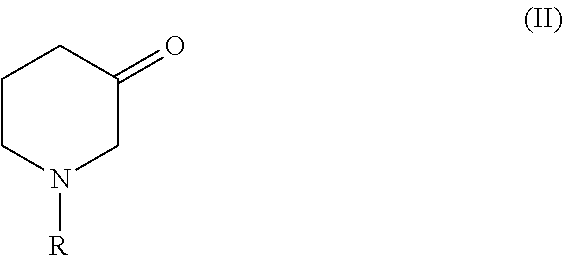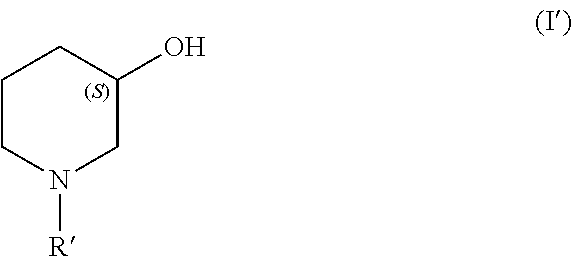Process for producing chiral 1 - substituted 2 - piperidinols employing oxidoreductases
- Summary
- Abstract
- Description
- Claims
- Application Information
AI Technical Summary
Benefits of technology
Problems solved by technology
Method used
Image
Examples
example 1
Preparation of Enzyme Solution
[0066]Competent Escherichia coli StarBL21 (De3) cells (Invitrogen) or RB791 cells (E. coli genetic stock, Yale, USA), respectively, were transformed with the expression constructs pET21-MIX coding for the different oxidoreductases. The Escherichia coli colonies transformed with the expression constructs were then cultivated in 200 ml of LB medium (1% tryptone, 0.5% yeast extract and, 1% NaCl) with 50 μg / ml of ampicillin or 40 μg / ml of kanamycine, respectively, until an optical density of 0.5, measured at 550 nm, was reached. The expression of recombinant protein was induced by adding isopropylthiogalactoside (IPTG) with a concentration of 0.1 mM. After 16 hours of induction at 25° C. and 220 rpm, the cells were harvested and frozen at −20° C.
[0067]For preparation of the enzyme solutions, 30 g of cells were resuspended in 150 ml of triethanolamine buffer (100 mM, pH 7, 2 mM MgCl2, 10% glycerol) and homogenized using high pressure homogenizer. Subsequentl...
example 2
Preparation of the Reaction Mixture
[0068]Reaction mixtures were carried out using reduced cofactors (A) and using oxidized cofactor in combination with suitable cosubstrate for regeneration of reduced cofactor (B).
[0069]Depending on specific requirements of the individual enzyme either potassium phosphate 100 mM pH=7.5 or triethanolamine buffer 100 mM pH=7.5 were used. In addition the buffer can contain 1 mM MgCl2 or 10% (v / V) for stabilization.
[0070]Reaction A[0071]160 μl buffer[0072]100 μl NADH / NADPH (40 mg / ml)[0073]20 μl 2-Propanol[0074]50 μl enzyme solution according to Example 1[0075]2 mg Tert-butyl 3-oxopiperidinecarboxylate
[0076]Reaction B (with 2-Propanol)[0077]450 μl buffer[0078]0.05 mg NAD / NADP[0079]50 μl enzyme solution according to Example 1[0080]10 mg Tert-butyl 3-oxopiperidinecarboxylate[0081]50 μl 2-Propanol[0082]50 μl enzyme for regeneration if required
[0083]Reaction B (with 4-Methyl-2-Pentanol)[0084]250 μl buffer[0085]0.05 mg NAD / NADP[0086]50 μl enzyme solution acco...
example 3
Preparation of tert-butyl (3S)-3-hydroxypiperidinecarboxylate Using Oxidoreductase SEQ ID NO1
[0091]75 μl of an enzyme suspension according to Example 1 of SEQ ID NO1 were added to a mixture of 450 μl of a buffer (100 mM potassium phosphate, pH 7.5, 1 mM ZnCl2), 50 mg Tert-butyl 3-oxopiperidinecarboxylate, 0.05 mg NAD and 50 μl 2-propanol. The reaction mixture was incubated at room temperature under constant thorough mixing. After 24 h the substrate was completely converted to the corresponding tert-butyl (3S)-3-hydroxypiperidinecarboxylate showing an enantiomeric excess of >99.8%.
PUM
 Login to View More
Login to View More Abstract
Description
Claims
Application Information
 Login to View More
Login to View More - R&D
- Intellectual Property
- Life Sciences
- Materials
- Tech Scout
- Unparalleled Data Quality
- Higher Quality Content
- 60% Fewer Hallucinations
Browse by: Latest US Patents, China's latest patents, Technical Efficacy Thesaurus, Application Domain, Technology Topic, Popular Technical Reports.
© 2025 PatSnap. All rights reserved.Legal|Privacy policy|Modern Slavery Act Transparency Statement|Sitemap|About US| Contact US: help@patsnap.com



